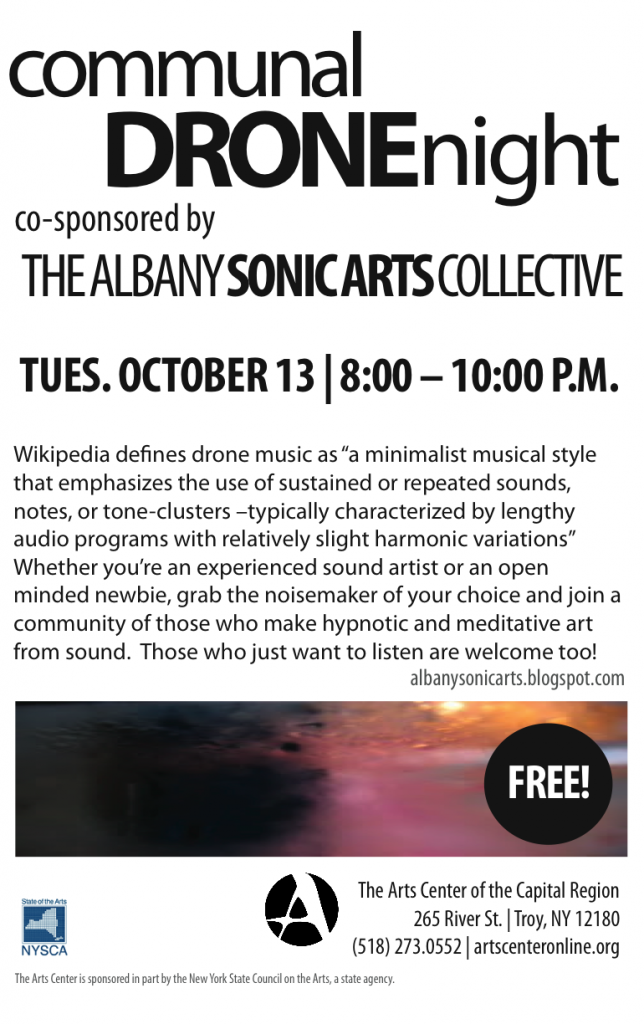Here’s the PR lowdown on the upcoming Faust show – lightly edited to make it somewhat more blog-worthy.
PROCTORS and the ALBANY SONIC ARTS COLLECTIVE
present
FAUST
Legendary “Krautrock” band featuring, and founded by, former Schenectady resident, Jean-Hervé Peron
AT PROCTORS SEPTEMBER 30th
Schenectady, NY – Faust will perform at The GE Theatre at Proctors on Wednesday, September 30 at 7:30 P.M.
Take the danger of Velvet Underground, the playfulness of early Frank Zappa, the epic experimentation of Pink Floyd, and sprinkle in some post-WII American Jazz, and you might just come up with a sound approximating the legendary Faust. Jean-Hervé Peron founded Faust in Germany in 1969 just one year after a stint at Schenectady’s Mont Pleasant High School. Faust quickly became a key figure in 20th Century music, a leading the way for “Industrial” and “Post-Punk” rock and defining “Krautrock” along the way.
Along with Kraftwerk, Can and Tangerine Dream, Faust re-invented pop music and revolutionized the whole process of musical production with their mix of aggressive hypnotic grooves, satirical pop, electronic collages and delicate waves of pastoral ambience. Faust dabbled with every conceivable musical genre, sometimes simultaneously, and the music has lost none of its immediacy or relevance—it sounds as if it was recorded last week, not last decade. Amongst those Faust have influenced include such diverse groups as Sonic Youth, My Bloody Valentine, Wilco, Pavement, The Boredoms, Joy Division, Brian Eno, Cabaret Voltaire, Einstürzende Neubauten, and a host of Industrial and Techno bands.
Faust have only made two prior brief trips to the US (in 1994 and 1999), their current line-up including original members Jean-Hervé Peron and Werner “Zappi” Diermaier, along with James Johnston (Nick Cave and the Bad Seeds, Lydia Lunch, Gallon Drunk) and visual/video artist, painter, and musician Geraldine Swayne.
Also performing will be the following Capital Region performers, both of whom will be supported with video by Jason Cosco
Century Plants are an Albany-based experimental guitar duo that traffic in “slow motion psych drift, lazy and blown out” and have been described as “part raging metallic clang by way of the holy Shred, part meditative feedbacking in total Zen style”. Directly influenced by the hypnotic repetition of Faust and other German rock bands of the 1970s, along with minimalism, and a range of experimental rock and noise, Eric Hardiman and Ray Hare conjure a fully improvised sound that ranges from gentle drones to “a lysergic sprawl that eventually builds to full on chaotic cacophony”. Century Plants are highly regarded in the underground noise/psych/rock/drone scene internationally and have released music on labels from all over the globe. Their debut LP is due out this Fall on the Music Fellowship label. http://www.myspace.com/centuryplants
Holland Hopson is a composer, improviser, and electronic artist. As an instrumentalist he performs on soprano saxophone, clawhammer banjo and electronics. He hopes someday to play the musical saw. He has held residencies at STEIM, Amsterdam; Experimental Music Studios, Krakow and Katowice, Poland; Sonic Arts Research Studio, Vancouver, Canada; and Harvestworks Digital Media Arts, New York where he developed a sound installation based on Marcel Duchamp’s With Hidden Noise. In 1993- 1994 Holland recorded environmental sounds on four continents and in over a dozen countries as a fellow of the Thomas J. Watson Foundation. http://hollandhopson.com/
FAUST PRESS:
“Faust are essential, not just as a history lesson, but as a living legacy and as a reproach to an underachieving age.” —Melody Maker
“A radical mix of Musique Concrete, Stockhausen, the Velvet Underground, and moments of almost pastoral beauty.” —NME
“There is no group more mythical than Faust.” —Julian Cope
“Anyone who’s loved the last half-decade’s re-invention of the guitar, (Sonic Youth, My Bloody Valentine et al.), will instantly recognize Faust as a prime ancestor of ‘our’ music.” —Melody Maker
“Faust were first!” —Time Out
Tickets for Faust at The GE Theatre at Proctors on Wednesday, September 30 at 7:30 P.M. are $29.50. Tickets are available at Proctors Box Office, (518) 346-6204, or online at proctors.org.



